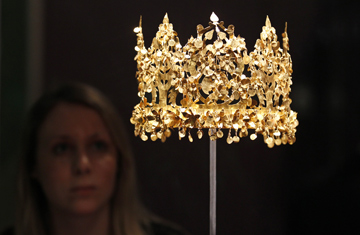
A museum employee poses for photographers behind a gold crown during a preview of an Afghanistan art exhibition at the British Museum in London
In the minds of many outside the country, Afghanistan occupies a space somewhere between war and chaos. But millennia before the Soviet invasion kicked off 30 years of conflict and upheaval, and well before the Taliban began to brutalize its own people, Afghanistan flourished as a hub along the Silk Road. From as early as the first century B.C., the region was known as a meeting place for artisans and traders, not warlords and insurgents.
That's the implicit message of the British Museum's latest blockbuster exhibition, Afghanistan: Crossroads of the Ancient World. Running until July 3, it brings together 230 objects that have survived bombings and lootings and deliberate destruction by the Taliban. "I hope this exhibition will introduce our ancient civilization to the British people, who usually hear stories of killing in Afghanistan," says Omara Khan Masoodi, the director of Kabul's National Museum, which has loaned all of the artifacts on display while it is being rebuilt following years of war. "Afghani people aren't just fighting with each other. They love their culture, their art, and know the value of these things."
The Afghanistan on show at the London museum sits at the center of trade routes — not the periphery of the civilized world. It conveys all the color you'd expect from a place where the frontiers of China and the Greek Empire were just a camel ride away. In one display, an ivory figurine depicts a voluptuous woman swishing her hips and standing on a makara, a sea creature from Hindu mythology. A few feet away, a bronze Eros looks bemused at the fact that he was exhumed north of Kabul instead of in Rome.
Most impressive, however, are the rows of golden implements unearthed in Tillya Tepe — the "Hill of Gold" — in the northern plains of Afghanistan. Found in the tombs of a nomad prince and five female relations, the treasure trove includes gold and turquoise leg bracelets shaped like snakes, clasps depicting Cupid riding a dolphin, a pendent of a Chinese man taming two dragons, and a collapsible crown consisting of four golden trees.
And while the beauty of the artifacts give the show its dazzling sheen, the story of their survival gives it gravity. Over the past 30 years, around 70% of the artifacts housed in Kabul's National Museum have been destroyed or looted and smuggled out of the country and onto the black market. That's 70,000 precious objects lost. In 1994, a rocket launched by guerrilla fighters during the country's civil war destroyed some of them (and much of the museum, which was being used as an Afghan military base at the time). Robbers cut up a number of wooden statues to use as firewood, and melted down golden implements as booty. Later, Taliban officials smashed other relics in an effort to erase the country's pre-Islamic history — a policy that saw them dynamite the 6th-century Bamiyan Buddha statues, carved into the side of a cliff, in March 2001.
During those dark days, museum officials risked their lives to keep thousands of artifacts out of Taliban hands. In 1988, with the security situation in Kabul continuing to deteriorate as the Soviet war raged in Afghanistan, museum officials hid artifacts such as the gold ornaments from Tillya Tepe and a stash of Bactrian gold in vaults deep beneath the Central Bank to protect them from the upheaval. Five men held a key, and the vaults required all five keys to open; if any of the men passed away, his eldest child would inherit his key.
When the Taliban came to power eight years later, its militants demanded that the museum reveal the location of the hidden treasures. But officials — including Massoudi, one of the key holders — kept quiet in the face of threats. He and his staff remain reticent about their bravery, but Aghani President Hamid Karzai, in a prologue to the exhibition catalog, makes clear just how selfless they were. "A single piece of gold would have been a ticket to escape the war and destruction that afflicted our country, but not a single piece was lost," he writes. Karzai, with the help of Massoudi and the other key holders, opened the vaults in 2003.
Since the Taliban's ouster in 2001, art officials from the Kabul National Museum have spearheaded international efforts to reclaim their heritage. Working with UNESCO and Interpol, they have traced roughly 8,500 pieces of Afghani artifacts to countries including the U.S., U.K., Denmark, Norway and Switzerland. Officials also drafted a "red list" of missing antiquities and distributed it globally.
The success of that list takes center stage at the British Museum show, which features 20 ivory artifacts discovered in 1937 in the ancient city of Begram, north of modern-day Kabul, but stolen from the National Museum in the early 1990s. Once used to decorate furniture, the intricate carvings tell the story of Buddha's previous lives. A philanthropic donor in London recently discovered the items on the black market, and purchased them explicitly to return them to the museum in Kabul. Conservators at the British Museum worked with their Afghani counterparts to restore the carvings — and the exhibition reunites them with other artifacts once thought gone for good. The ivories are the final items on display, so visitors leave the show with their story in mind. "After the exhibition they will return to the National Museum of Kabul," says Neil MacGregor, director of the British Museum. "We're particularly pleased that the exhibition can end on this note of hope."
By raising awareness of the Afghani treasures lost, found, and — perhaps most importantly — still out there waiting to be recovered, that end may prove to be a new beginning.
— With reporting by Elizabeth Tyler / London
